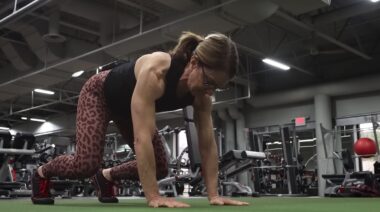Let’s start with the first and most commonly known thing about the plank and that is how to perform one. A standard plank is performed with arms shoulder-width apart and toes on the ground, raise your body until your body is in a line, from the top of your head to the top of your heels. If you are interested in learning more about the plank and its history and variations, continue reading below.
Let’s start with the first and most commonly known thing about the plank and that is how to perform one. A standard plank is performed with arms shoulder-width apart and toes on the ground, raise your body until your body is in a line, from the top of your head to the top of your heels. If you are interested in learning more about the plank and its history and variations, continue reading below.
How Planks Became So Ubiquitous
It all started with Joseph Pilates. That’s right, the inventor of the massively popular Pilates system is said to “invent” the plank. In Pilates, he would perform an exercise known as leg pull front. This exercise would be performed for reps and as a strengthening exercise.
And while we see several of the movements from pilates come up, this one’s popularity is not just due to Pilates. It wasn’t really until 2005 when Brian MacKenzie came out with his 101 Evaluation Tests for athletes where the plank was used to determine core strength. We then saw other people jump into the fray.
First Ace Fitness began to jump in and talk about the benefits of the plank. Expressing that the sit-up should be replaced by the plank. Then in 2009, the International Association of Fire Fighters included the plank in their fitness evaluation. Today, the International Sports Science Association calls planks one of the most effective abdominal exercises one can do.
If you want to dig a little deeper, try The History of the Plank Exercise by Conor Heffernan.
Is the Plank an Accurate Marker for Abdominal Strength?
So, we move forward to today. While I agree that the plank is one of the simplest and easiest exercises to coach and perform there is, let’s look at what it is good for. It is no secret that the plank is an easy way to quantify the core stability and muscular endurance of your core.
However, if you look at the world record holder George Hood, who is a 62-year-old former Marine who has a record for holding a static-hold plank for 8 hours 15 minutes and 15 seconds. What in impressive feat!
So while impressive, common thought would illustrate that it is more of a specific adaptation rather than a universal marker of strength. If it were a universal marker of strength, we would see individuals between 20-40 years old peaking on this rather than a 62-year-old man.
We are in our peak performance age between 20-40 years old. So we are able to build our static sagittal core stability while performing this exercise, however, it’s expression as the be-all and end-all of abdominal strength is overstated.
The Limitations of Planking
The core is capable of doing a great many things. The first limiting factor is that it does not work or improve our rotational stability; this can be done with a side plank with a reach through.
By turning on your side and reaching one arm up to the sky and stretching as far as you can and returning to the starting position, you are improving the rotational core stability and strength.
We can also do a side plank manipulation where you touch your hip to the ground and elevate to work your obliques. Beyond this, for those of us obsessed with the rectus abdominis or the six-pack, you can do a low mountain climber to really work those muscles.
The myth of the plank working the glutes goes back to Pilates’ root exercise. When you plank your glutes are in their natural position thus you are not actually not fighting gravity thus this is the same as just squeezing the muscles.
An amazing variation of the plank is actually the reverse plank; this is much harder and has resistance in the glutes and scapular retractors. In the reverse plank, you will flip over facing the ceiling squeezing your back and glutes tight to elevate yourself.
Today you will not find a single abdominal routine that does not incorporate some variation of the plank. There are amazing devices out there to help you perform the plank. That will assist you in timing, positioning, as well as cushioning.
The plank is an activity that no exercise routine is complete without, however, we need to make sure that we do not overemphasize it. While it should be included it shouldn’t be over-promoted.






